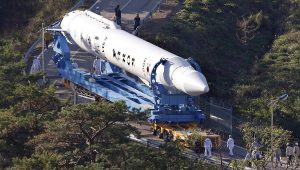On October 26, South Korea made its third attempt to launch its first rocket, the Korean Space Launch Vehicle KSLV-1. The launch was aborted when a leak was detected between the launch pad fueling system and the first stage.
“An injection of helium to check for any leaks pointed to a loss of pressure, raising suspicions of a possible leak,” according to Yonhap news agency. “Following an investigation, officials later confirmed that a seal in a coupling device had been damaged.”
Originally the delay was anticipated to be just three days, and that only because replacing the seal on the interface required the vehicle to be moved off the launch pad. “If the problem is easily fixed, it could take three days from now to launch the rocket. But if the problem is more complicated than we currently suspect, it might take more time,” said an official quoted by Yonhap at the time. Officials now say that the rescheduled launch won’t take place before mid-November, partially due to regulatory filing requirements.
The KSLV is based on Russian technology, with its first stage, sporting a RD-151 kerosene/liquid oxygen engine, being entirely built by Russian contractor Khrunichev. South Korea built the solid rocket second stage and payload fairing, as well as the small satellite intended for launch.
This is South Korea’s third attempt at launching KSLV-1. Prior attempts in August 2009 and June 2010 both ended in failure.
South Korean and Russian engineers concluded on Sunday that further investigation is needed to understand the cause of the seal damage. Officials are scheduled to announce plans for the next attempt in the upcoming week.
Watch the explosion of the June 2010 KSLV-1 shortly after its launch:


















































































































![A trajectory analysis that used a computational fluid dynamics approach to determine the likely position and velocity histories of the foam (Credits: NASA Ref [1] p61).](http://www.spacesafetymagazine.com/wp-content/uploads/2014/05/fluid-dynamics-trajectory-analysis-50x50.jpg)



Leave a Reply